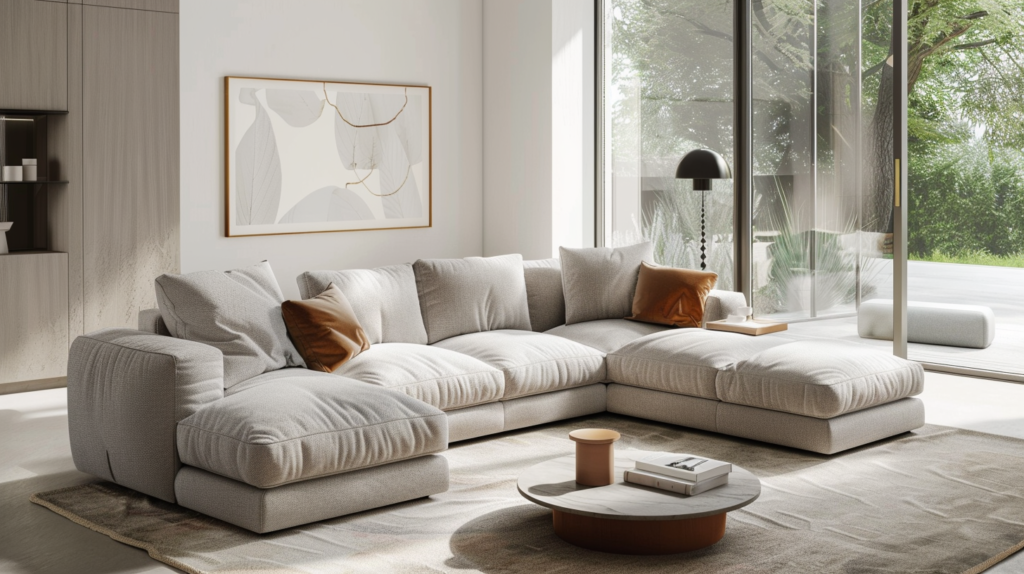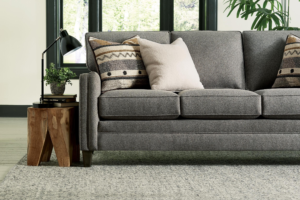Yes, sofa fabric can be dyed, but it depends on several factors, such as the type of fabric, the current color, and the fabric condition. Dyeing sofa fabric is an option to refresh or change its color, but it requires careful preparation and understanding of the process to achieve successful results. Below is a detailed guide covering the types of fabrics that can be dyed, the method, and things to watch out for when dyeing your sofa fabric.
1. Fabric Type Matters
Not all fabrics respond well to dyeing. The ability to dye a sofa’s fabric largely depends on the fiber content of the material. Here’s a breakdown of how different fabric types react to dye:
Fabrics That Can Be Dyed:
- Natural Fibers: Fabrics like cotton, linen, wool, and silk are the easiest to dye because they readily absorb color.
- Cotton and Linen: These natural fabrics take dye well and provide even coloring with the right preparation.
- Wool and Silk: These also dye well, but they require acid-based dyes and careful handling due to their delicate nature.
- Rayon: Though synthetic, rayon (a semi-synthetic fiber) can absorb dye similar to natural fibers, making it a good candidate for dyeing.
Fabrics That Are Difficult or Impossible to Dye:
- Polyester and Other Synthetics: Polyester and acrylic are extremely difficult to dye. These synthetic fibers resist water-based dyes and typically require disperse dyes, which are more complex to use and require higher temperatures than can be achieved with regular home dyeing methods.
- Blended Fabrics: Blends of natural and synthetic fibers (like cotton-polyester blends) can be challenging because the natural fibers will absorb dye, while the synthetic fibers may not. This can result in an uneven or muted color.
- Microfiber: Made from tightly woven polyester or nylon, microfiber is challenging to dye effectively, and the results may be inconsistent or unsatisfactory.
2. Preparation is Key
Clean the Fabric Thoroughly
Before dyeing, it’s essential to clean the sofa fabric to remove any dirt, oils, or fabric treatments that could prevent the dye from penetrating evenly.
- Vacuum the fabric thoroughly to remove dust, dirt, and debris.
- Spot-clean stains using a mild detergent or fabric cleaner.
- If possible, machine wash the removable cushion covers, following the fabric care instructions.
Test a Small Area First
Always test the dye on a hidden or inconspicuous part of the fabric (such as the underside of a cushion) to see how well it absorbs and whether the color comes out as expected. This is especially important for sofas with a mix of fibers or synthetic components.
3. Choose the Right Dye
The type of dye you use will depend on the fabric composition. Here’s a look at the types of dyes available:
For Natural Fibers:
- Fiber-Reactive Dyes (like Rit Dye or Procion MX): These are the best for cotton, linen, and rayon. They bond directly with the fabric fibers, producing vibrant, long-lasting colors.
For Synthetics:
- Disperse Dyes: Designed for synthetic fibers like polyester and nylon, disperse dyes are difficult to use at home because they require boiling temperatures and specialized equipment.
For Blended Fabrics:
- Use all-purpose dyes like Rit Dye that can work on both natural and synthetic fibers, but note that the color may be less vibrant on the synthetic portion of the fabric.
4. Dyeing Methods
There are several methods to dye your sofa fabric, but some are easier for home use than others:
1. Machine Dyeing (for removable covers)
If your sofa has removable cushion covers, machine dyeing is one of the easiest and most effective methods.
- Step 1: Remove the cushion covers and check that they are machine-washable.
- Step 2: Use a large-capacity washing machine. Follow the instructions on the dye package, adding the correct amount of dye, salt (for fiber-reactive dyes), and water.
- Step 3: Wash the covers with the dye in the hottest water safe for the fabric.
- Step 4: Run the covers through a rinse cycle until the water runs clear.
- Step 5: Dry the covers according to fabric care instructions—either air dry or machine dry if permitted.
2. Dip Dyeing (for non-removable fabric)
For sofas where the fabric is not removable, dip-dyeing can be used, but it requires careful handling.
- Step 1: Prepare a large container with enough water and dye to submerge the fabric fully. You’ll need to treat the sofa as if you were dyeing a large fabric piece.
- Step 2: Apply the dye using a sponge or brush to ensure even coverage. For larger areas, soak rags in dye and gently press them against the fabric.
- Step 3: Be cautious with soaking the fabric too much, as it can saturate the sofa’s inner padding.
3. Spray Dyeing
This method involves using fabric dye sprays and can be easier for those dyeing upholstered sofas that can’t be removed or washed. Fabric spray dyes are designed for upholstery and provide an even finish without saturating the fabric.
- Step 1: Cover non-fabric areas like wood or metal with plastic or painter’s tape to protect them from the dye.
- Step 2: Spray the dye evenly over the fabric in light, sweeping motions.
- Step 3: Allow the fabric to dry completely between coats.
- Step 4: Add multiple coats as needed to achieve the desired color intensity.
5. Aftercare
After dyeing your sofa fabric, setting the dye and ensuring proper aftercare will extend the longevity of the color.
- Heat Setting: For some dyes (especially for natural fibers), heat setting is required to lock the color in. Use an iron or put the fabric in a dryer at a low setting if the care label allows.
- Washing and Cleaning: Be cautious when cleaning the dyed fabric. Hand-wash or use cold water to prevent the color from fading quickly. Avoid harsh detergents.
- Colorfastness: Keep in mind that exposure to sunlight may fade the color over time, especially for cotton or linen. Consider using a fabric protector spray to help preserve the dye job.
Pros and Cons of Dyeing Sofa Fabric
Pros:
- Cost-Effective Makeover: Dyeing your sofa fabric can be a much cheaper alternative to replacing the sofa or reupholstering it.
- Creative Freedom: You can choose almost any color and refresh the look of your furniture to match your decor.
- Sustainable: It extends the life of your furniture, reducing the need to buy new items and contributing to sustainable living.
Cons:
- Uneven Dyeing: If the fabric is a blend or has synthetic fibers, the dye may not take evenly, resulting in patchy coloring.
- Time-Consuming: Dyeing a large piece of fabric like a sofa cover can take time and effort, especially if using a manual method like dip or spray dyeing.
- Color Limitations: You cannot dye fabric to a lighter shade without bleaching it first. The dye can only darken or deepen the existing color.
- Potential Damage: Using too much water or dye on non-removable fabric can damage the sofa’s internal padding or structure.
Conclusion
Yes, sofa fabric can be dyed, but success depends on the type of fabric, the method used, and proper preparation. Natural fibers like cotton and linen dye well, while synthetics like polyester are harder to dye and may require specialized products. Always start with a test patch, choose the appropriate dye for the fabric type, and follow a precise method to ensure even and lasting results. If done correctly, dyeing can be a cost-effective and creative way to refresh your sofa and give your living space a new look.











